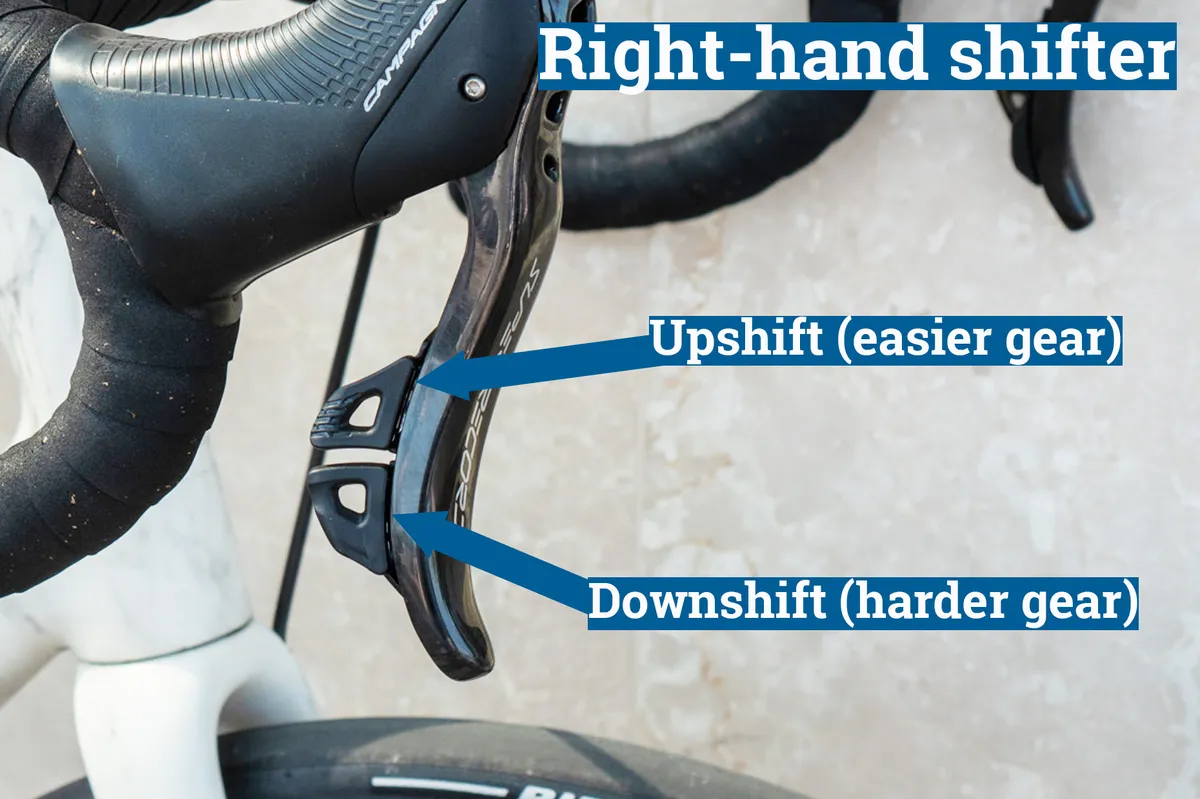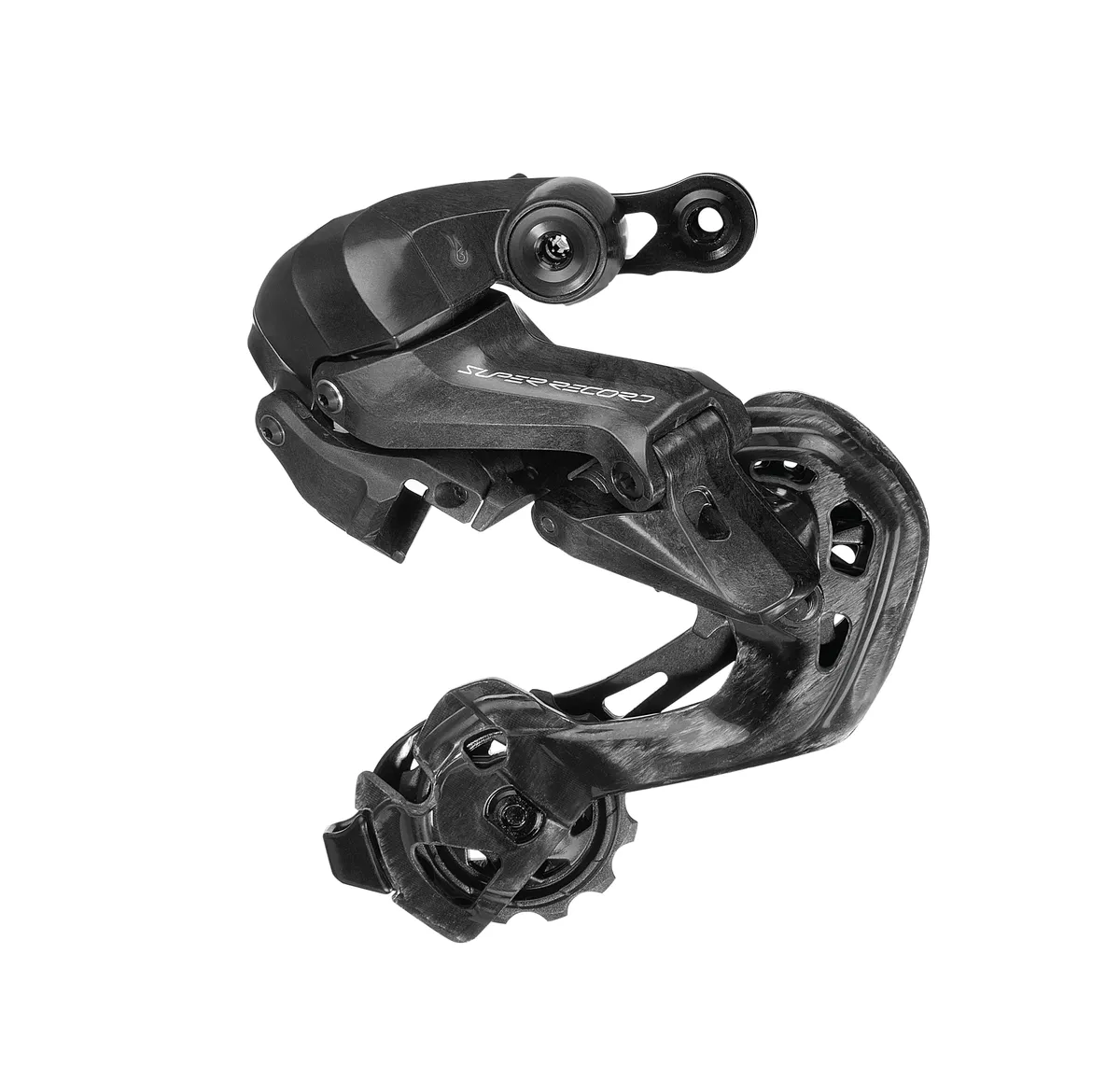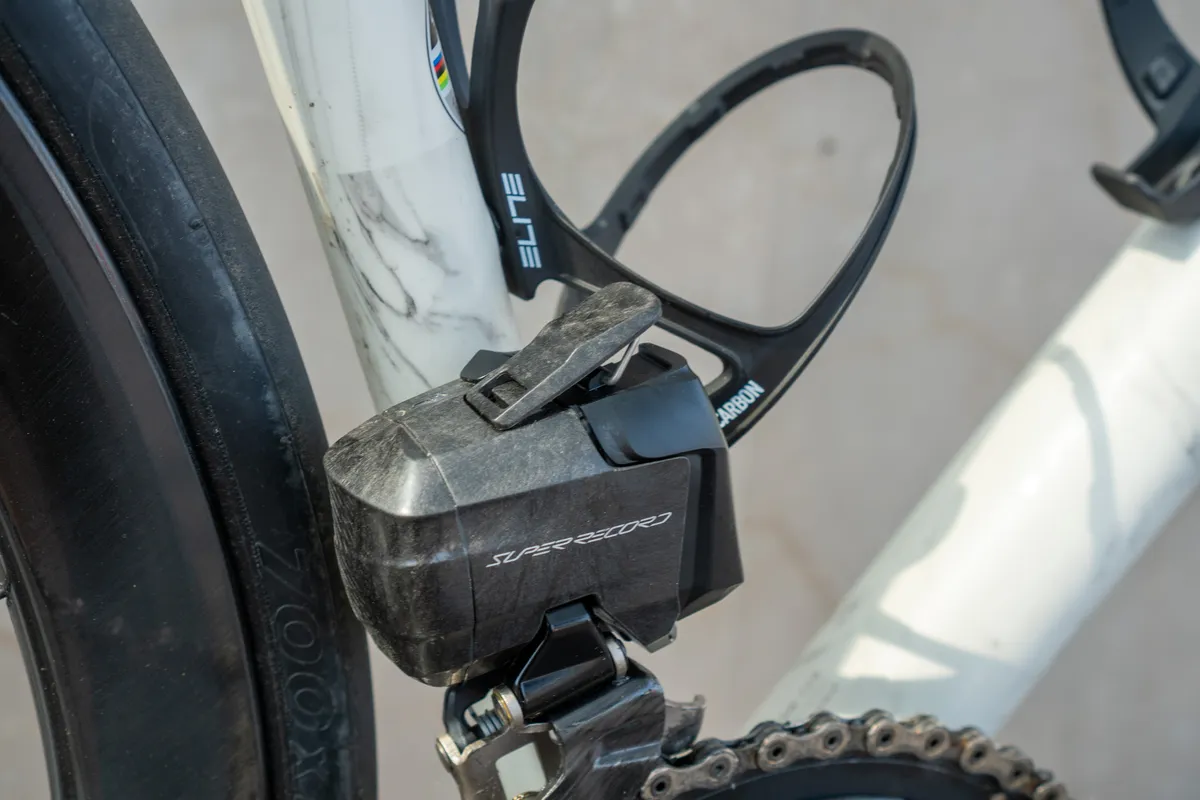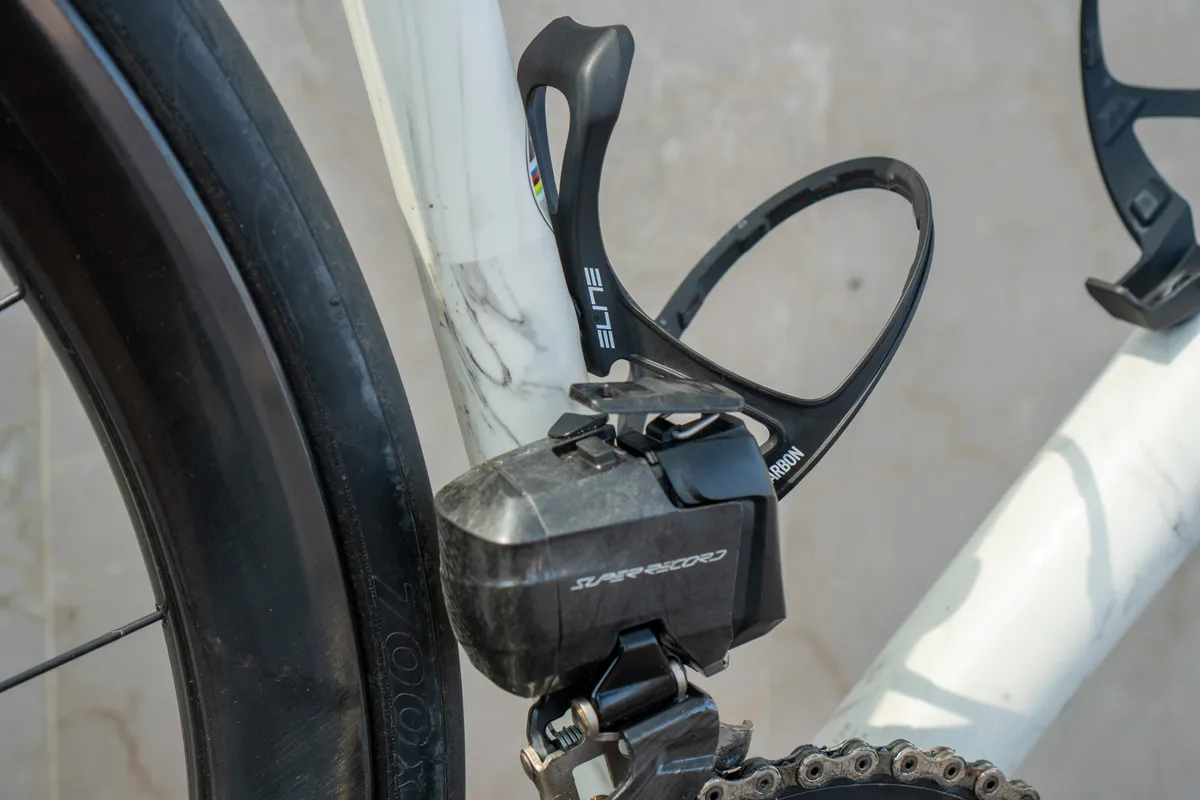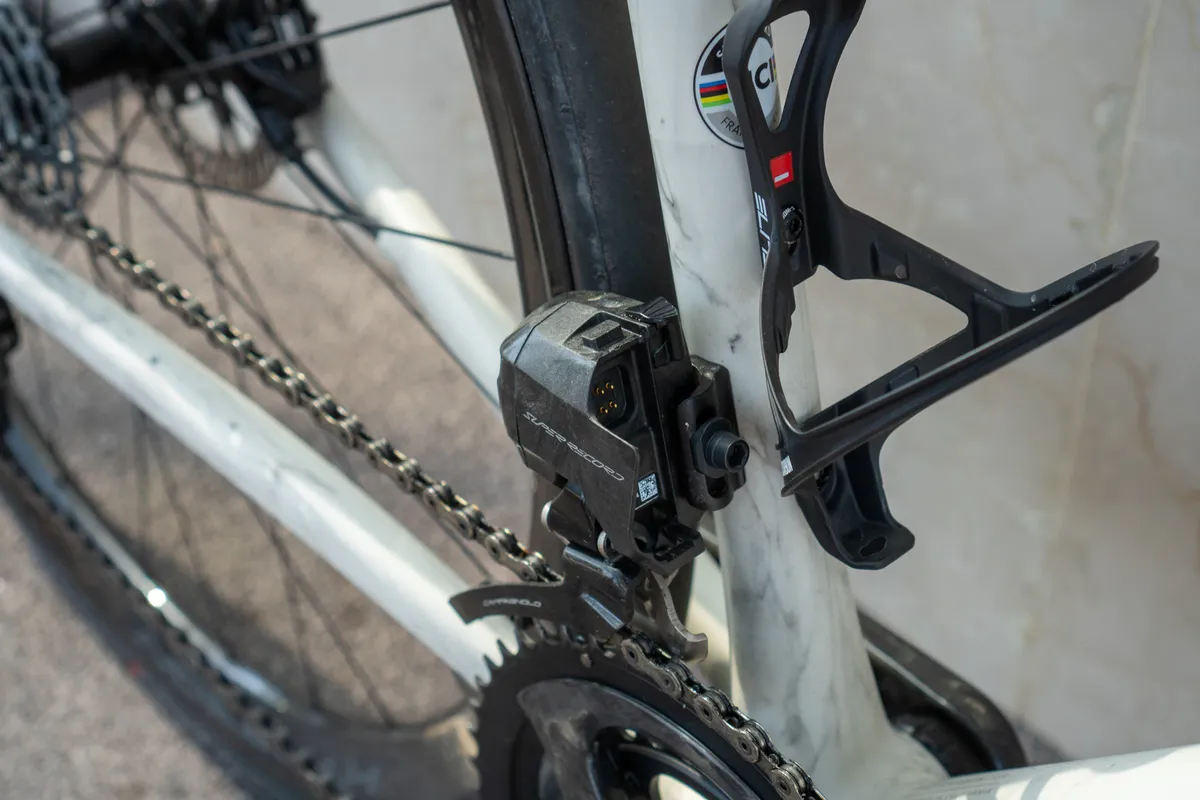Campagnolo Super Record Wireless is the brand’s long-awaited new halo 12-speed wireless electronic groupset.
Not only does the electronic groupset ditch the thumb lever synonymous with the Italian brand, it also casts out rim brakes.
The brand also claims faster shifting speeds and improved braking. Super Record Wireless is available in 2x gearing only and the cassettes now start with a smaller 10t cog.
Super Record Wireless is Campagnolo’s first road bike groupset release since 2019 and weighs in at a claimed 2,520g (in its lightest configuration with a 45/29 crankset and 10-25t cassette).
The groupset is available now and will retail for £4,499/$5,399/€5,200. Australian pricing is to be confirmed. Campagnolo hasn’t provided claimed weights or individual pricing for any of the components.
We initially spotted the groupset when it leaked on various retailer websites.
Canyon, Colnago, Pinarello, Specialized and Wilier will be offering bikes with the groupset at launch, with BMC soon to follow.
Want to know our initial impressions of the groupset? Check out our first ride review, as well as a column mourning the death of the thumb shifter and a look at the first bikes to feature the new flagship groupset. Read on for all the key details.
8 things you need to know about Campagnolo Super Record Wireless
- Super Record Wireless is 12-speed
- Campagnolo has ditched the iconic thumb shifter and introduced a new shifting logic
- There are three cassette options, all starting with a smaller 10t cog
- The front and rear derailleurs are claimed to shift faster than Super Record 12 EPS
- Due to the smaller 10t cog, Campagnolo is offering smaller chainring sizes
- Super Record Wireless inherits Campagnolo’s ProTech bottom bracket system, first found on its Ekar gravel groupset
- Campagnolo has finally introduced a quick link to its 12-speed chain
- The brand says it will not be developing an updated mechanical Super Record groupset
Campagnolo Super Record Wireless key features

Campagnolo Super Record Wireless is, as the name suggests, wireless.
The previous generation, Campagnolo Super Record 12 EPS, ran wires from the shifters to the derailleurs, connecting to a central battery.
Campagnolo says it’s a big step forward for the brand due to the simplified installation compared to routing wires and a battery.
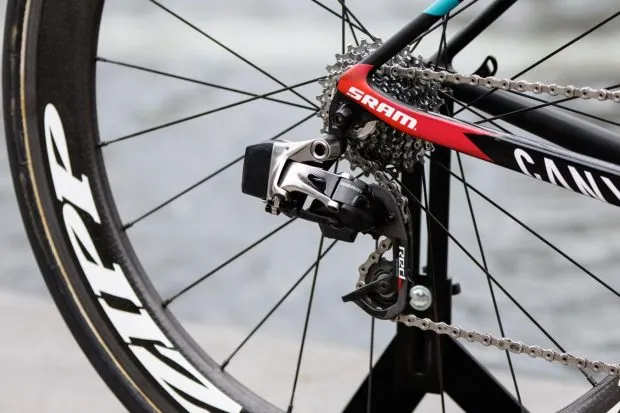
Campagnolo isn’t the first groupset manufacturer to introduce fully wireless electronic shifting – SRAM was first to the table with its Red eTap groupset in 2015.
Although its Ekar gravel groupset is 13-speed, Campagnolo decided to stick with 12-speed for its new flagship groupset, stating it is “more than enough for the road” in terms of range.

Super Record Wireless looks different from its predecessor. Gone are the red graphics, which are now replaced by a more subdued white, which the brand says suits a larger range of bikes.
The derailleurs feature removable batteries that can be charged on or off the bike. Campagnolo says the batteries will last 750km in heavy use but reckons you could get 1,000km from them in normal conditions.

Both derailleurs feature magnetic 'Mac-type' charging ports. Campagnolo claims the batteries can be charged to 90 per cent in 45 minutes or full in 60 minutes.
If you happen to run out of battery on a ride, Campagnolo says you can charge the system up to 20 per cent in 10 minutes, providing you’re carrying the charge cable.
You cannot swap the batteries between the derailleurs because they are different. Campagnolo says it needed to use different battery shapes to avoid infringing on SRAM’s patent.
SRAM shares batteries across its front and rear derailleurs, as well as other wireless components such as its dropper post, so they can be interchanged.
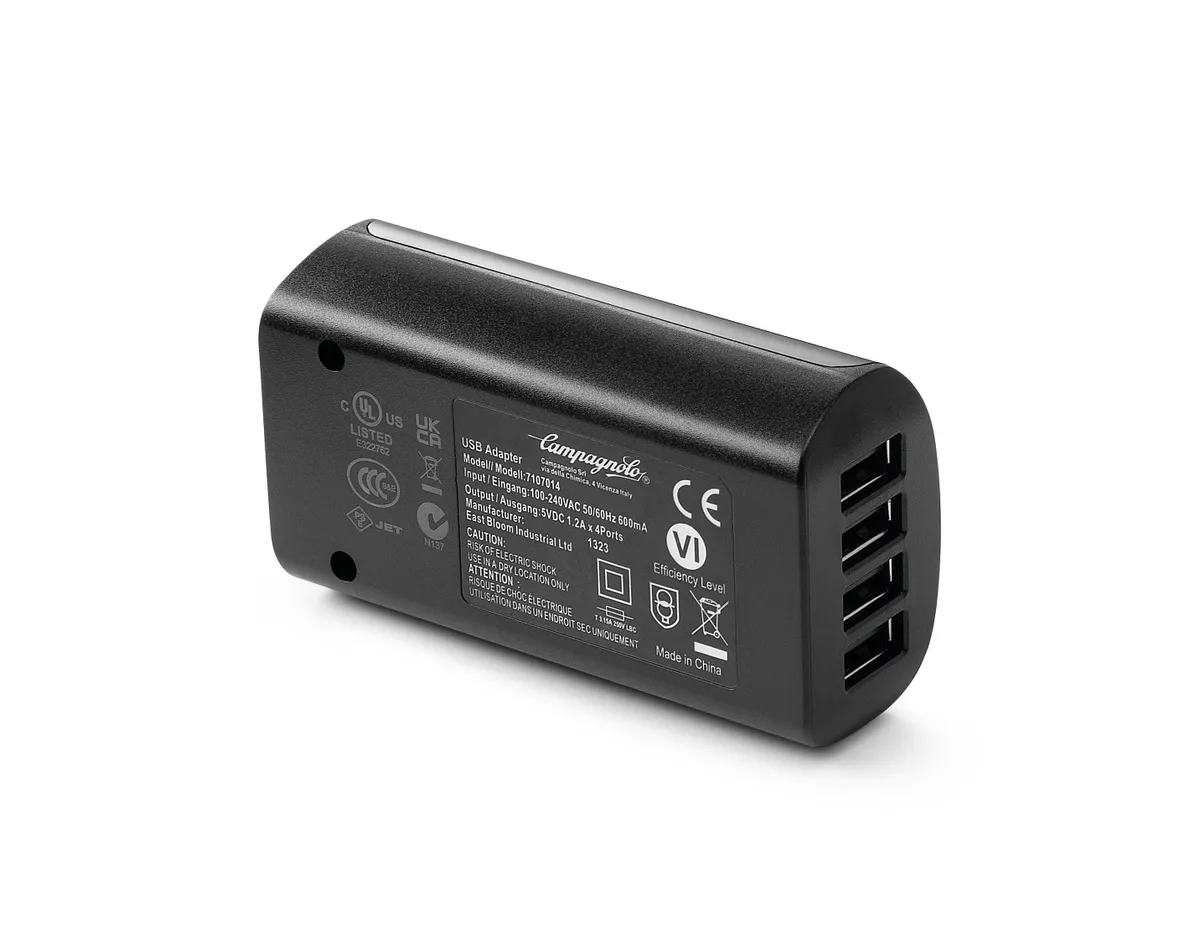
Campagnolo says replacement batteries are available if you want to carry spares on a ride. If the groupset runs out of charge, you will be stuck in whatever gear you happen to be in. Campagnolo says it is developing a ‘Ride Home Function’, where you can manually select a gear, and plans to roll this feature out in a future firmware update.
The electronic components of the groupset are ingress protection rated to IP69K (the outgoing Super Record 12 EPS groupset was rated to IP67).
Campagnolo says this level of protection means you can even pressure wash the components. The brand says it tested this in production, although it doesn’t recommend doing so.
Campagnolo will also be launching the MyCampy 3.0 app. This will enable you to monitor the charge of the components and customise the groupset’s settings.
The existing MyCampy app for the previous EPS groupset will continue to exist for now, but Campagnolo says it is planning to combine the two together.
Campagnolo Super Record Wireless shifters
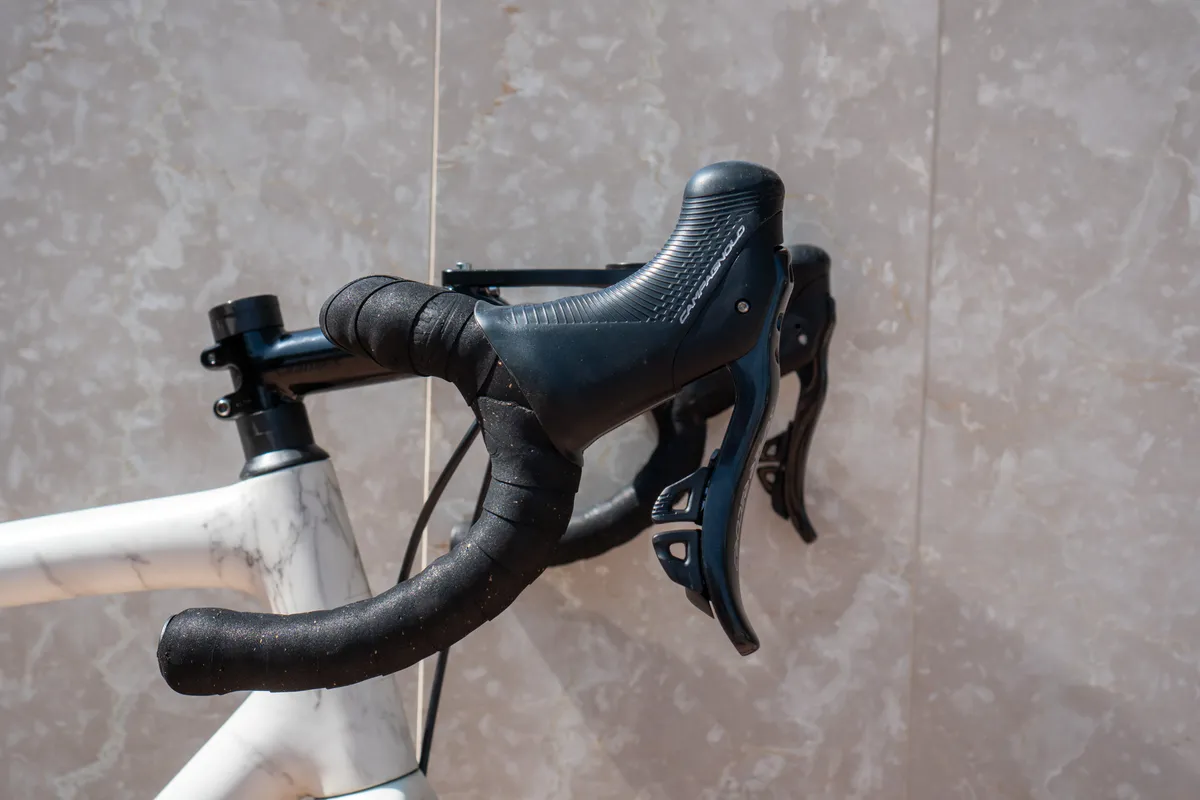
The shifters represent the most significant development, with Campagnolo ditching its iconic thumb shifter. Campagnolo’s previous shifters use a thumb shifter on the inside face to change into a smaller cassette cog or chainring.
The brand says the decision to remove the thumb shifter was market-oriented and it says there was a 50:50 split on whether people got on with it.
Each shifter paddle features two separate buttons, with Campagnolo referring to the shifting logic as “one lever, one action”.
In fact, the shifting arrangement is similar to Shimano Di2, only the buttons are separated vertically, rather than sitting side by side and overlaying each other. Unlike FSA’s K-Force WE, the buttons aren’t shared on a single rocker paddle.
By default, the uppermost button on the right shifter shifts the rear derailleur into an easier gear, with the lower button for a harder gear.
The uppermost button on the left shifter shifts you into the big chainring and the lower button into the small chainring.
However, you can customise the shifting logic in the MyCampy 3.0 app, if this isn’t to your tastes.
The body lever shape has been redesigned and Campagnolo says the new hood features extra grip and cushioning for enhanced riding comfort, as well as more efficient braking.
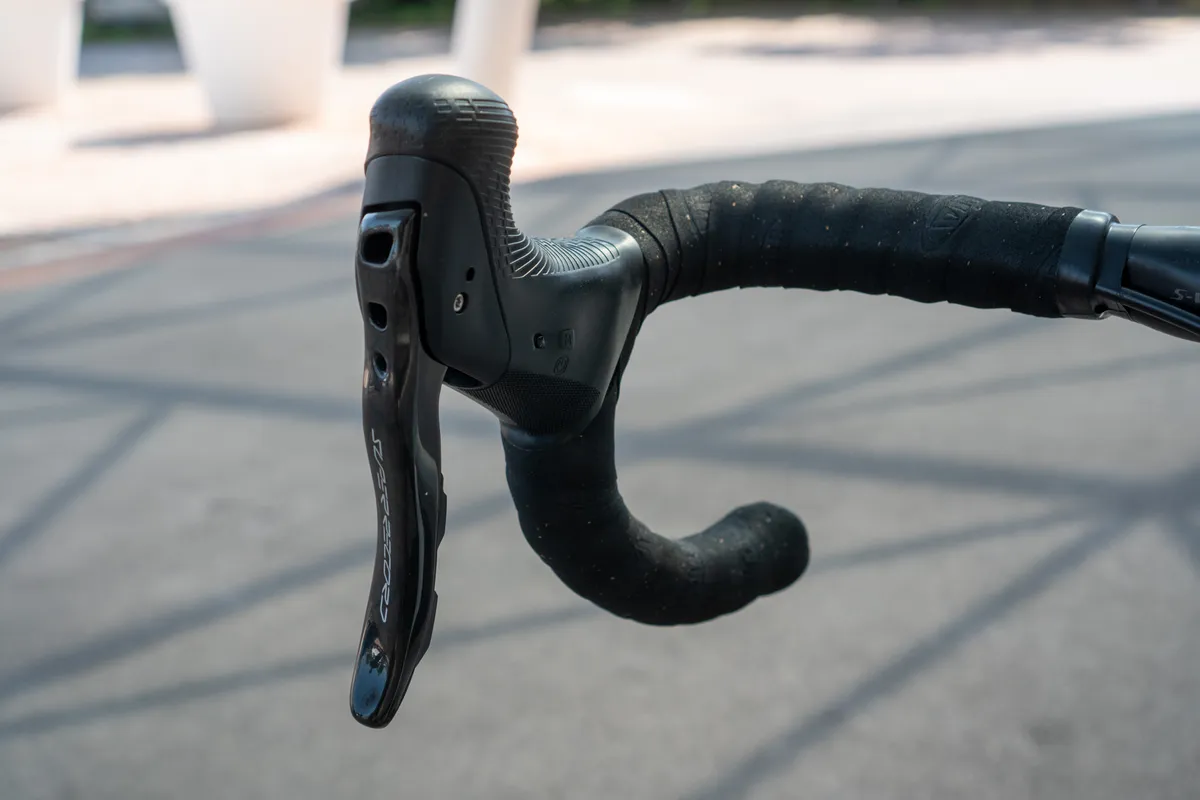
The lever is also a slightly different shape compared to its predecessor – a little shorter and wider than the previous Super Record 12 EPS groupset.
On the inside, where the thumb shifter used to live, are two mode buttons, which are used to set up the indexing and monitor battery life.
When you shift gear, a blue flash next to the mode button indicates good charge. If the light flashes red, that signifies there is less than 15 per cent of charge left.
Campagnolo has also removed the bump on the shifter hood where it transitions to the handlebar.

The shifters are powered by a CR2032 coin battery on the outside of each shifter. Campagnolo says it’ll last for two years, broadly in line with SRAM’s AXS and Shimano’s Di2 systems.
The levers feature 15mm of reach adjustment. This is adjusted with a 2.5mm hex bolt on the inside of the lever blade. Campagnolo has abandoned its AMS (Adjustable Modulation System) contact adjustment, which adjusted the bite point of the pads contacting the rotor because it found riders didn’t really use it.
The shifters communicate with the derailleurs via Bluetooth and ANT .
Campagnolo Super Record Wireless cassette

Like SRAM, Campagnolo’s road cassettes now start with a 10t cog and are made of CNC-machined steel.
Campagnolo will be offering three cassette sizes – 10-25t, 10-27t and 10-29t. Previous-generation 12-speed cassettes started with an 11t.
The 13-25/27/29 cluster is made of a single piece, with the 10, 11 and 12-tooth cogs separate pieces.
The cassettes run on Campagnolo’s N3W (Next Three Ways) freehub body. This standard was first introduced on its latest Shamal wheels a few months before Ekar’s release, with two of its cassettes using a 9t starting cog. The standard is backwards compatible with existing 10, 11 and 12-speed Campagnolo cassettes.

BikeRadar asked Campagnolo if it considered starting its cassettes with a 9t but the brand replied it wasn’t necessary. While the brand didn’t expand on this further, it may be due to additional potential drivetrain friction.
Like Ekar (which features six one-tooth jumps), Campagnolo has paid attention to optimising the tooth progressions. All of the cassette options feature at least six one-tooth jumps in the first six cogs and there are never any jumps larger than three teeth.
The ratios are as follows:
| High (12th) | 11th | 10th | 9th | 8th | 7th | 6th | 5th | 4th | 3rd | 2nd | Low (1st) | |
|---|---|---|---|---|---|---|---|---|---|---|---|---|
| 10-25 | 10 | 11 | 12 | 13 | 14 | 15 | 16 | 17 | 19 | 21 | 23 | 25 |
| 10-27 | 10 | 11 | 12 | 13 | 14 | 15 | 16 | 17 | 19 | 21 | 24 | 27 |
| 10-29 | 10 | 11 | 12 | 13 | 14 | 15 | 16 | 18 | 20 | 23 | 26 | 29 |
Campagnolo says the new groupset is not compatible with previous-generation 12-speed cassettes, and vice versa. It specifically stressed a 10-25t cassette is not compatible because the system has been designed around specific gear ratios.
Campagnolo Super Record Wireless rear derailleur
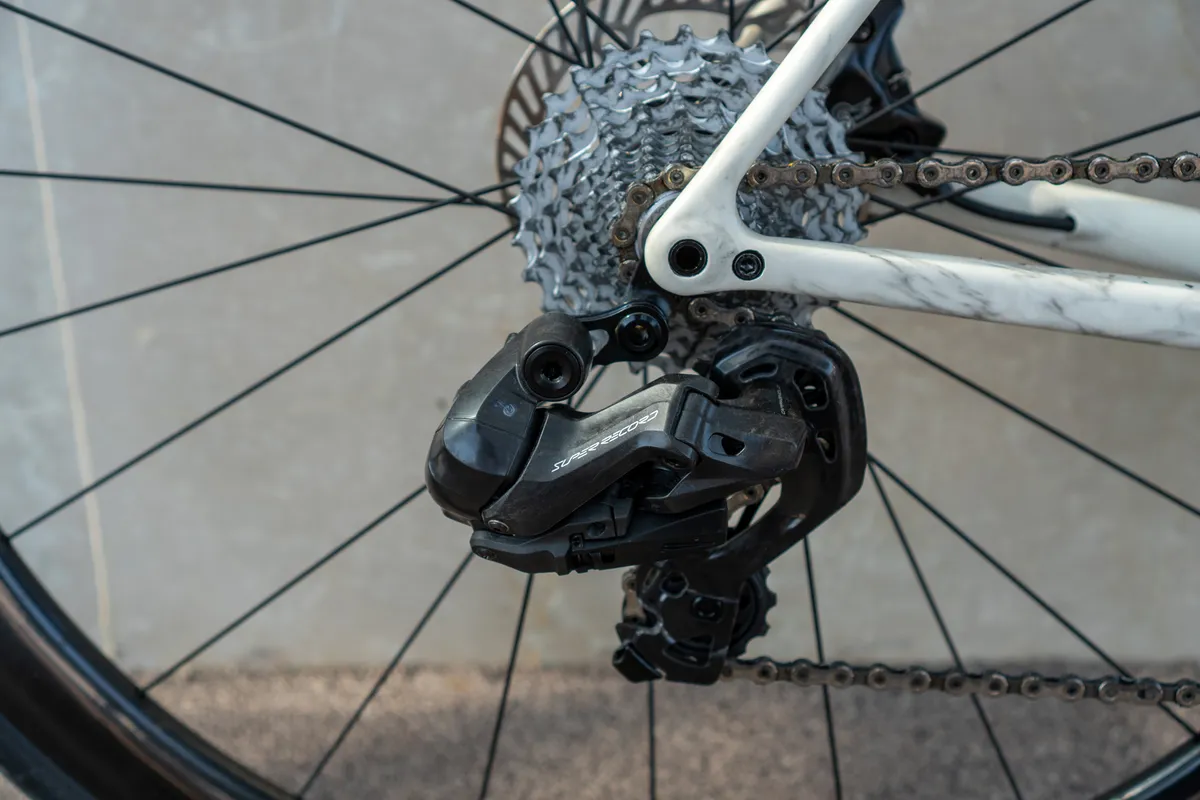
There’s just one rear derailleur to cover the three cassette options and it’s produced from technopolymer and carbon fibre.
Shifting speed is increased over Super-Record EPS and you can shift from one end of the cassette to the other by holding onto the relevant button, which Campagnolo calls MultiShift.
Unlike SRAM, which uses its Orbit clutch damper (or spring clutch on its Rival eTap AXS rear derailleur), Super Record Wireless doesn’t feature a clutch mechanism to manage the chain.
The derailleur cage has been redesigned and is now constructed from carbon fibre. The pulley wheels run on bushings.
Campagnolo wouldn’t reveal an official maximum cassette tooth capacity for the derailleur, but said it will work with a 32t sprocket, although somewhat contradictorily said the use of one is not recommended.
The derailleur features a safety mechanism, temporarily disengaging the derailleur if it takes a knock.
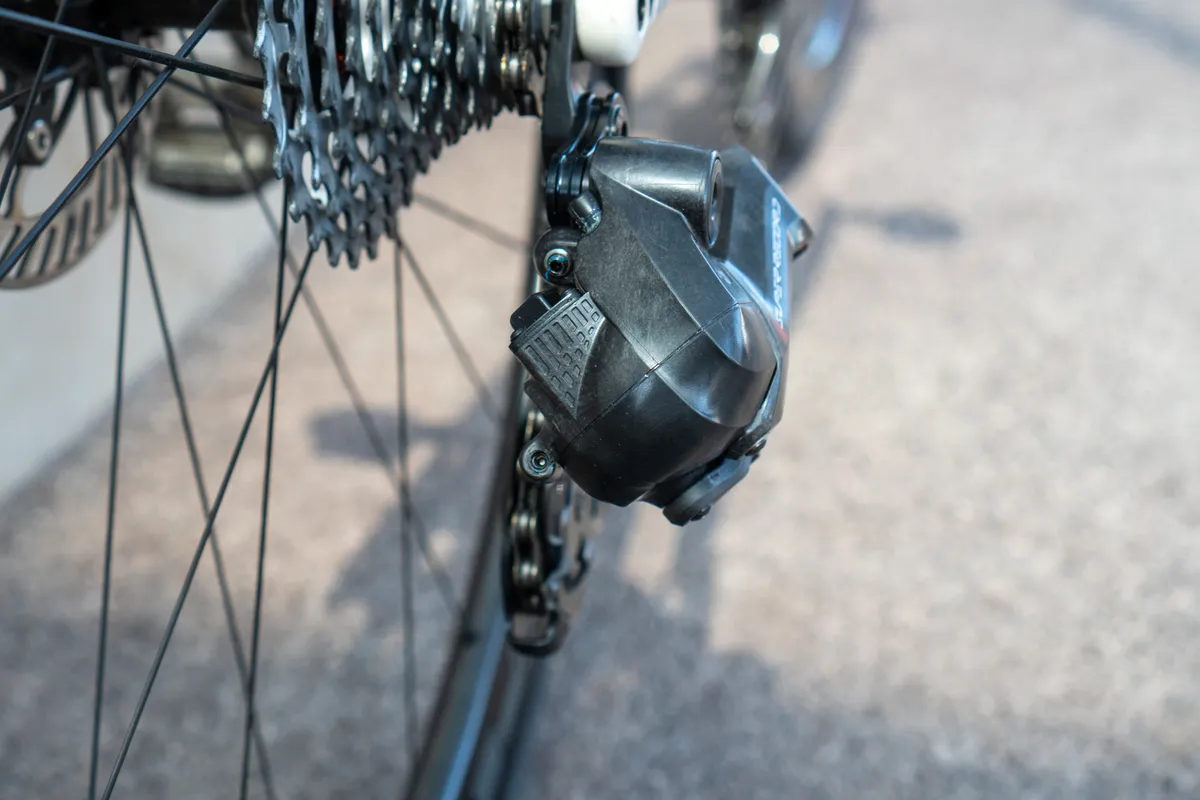
Unlike the outgoing EPS rear derailleurs, which can only move outwards in the event of an impact, Campagnolo says this new derailleur can move both out and inboard.
There’s a button on top of the rear derailleur to monitor battery life.
The rear derailleur features a B-gap adjustment and a high limit screw. Campagnolo says there is a physical low-limit function built into the upper body of the derailleur cage.
Campagnolo Super Record Wireless front derailleur
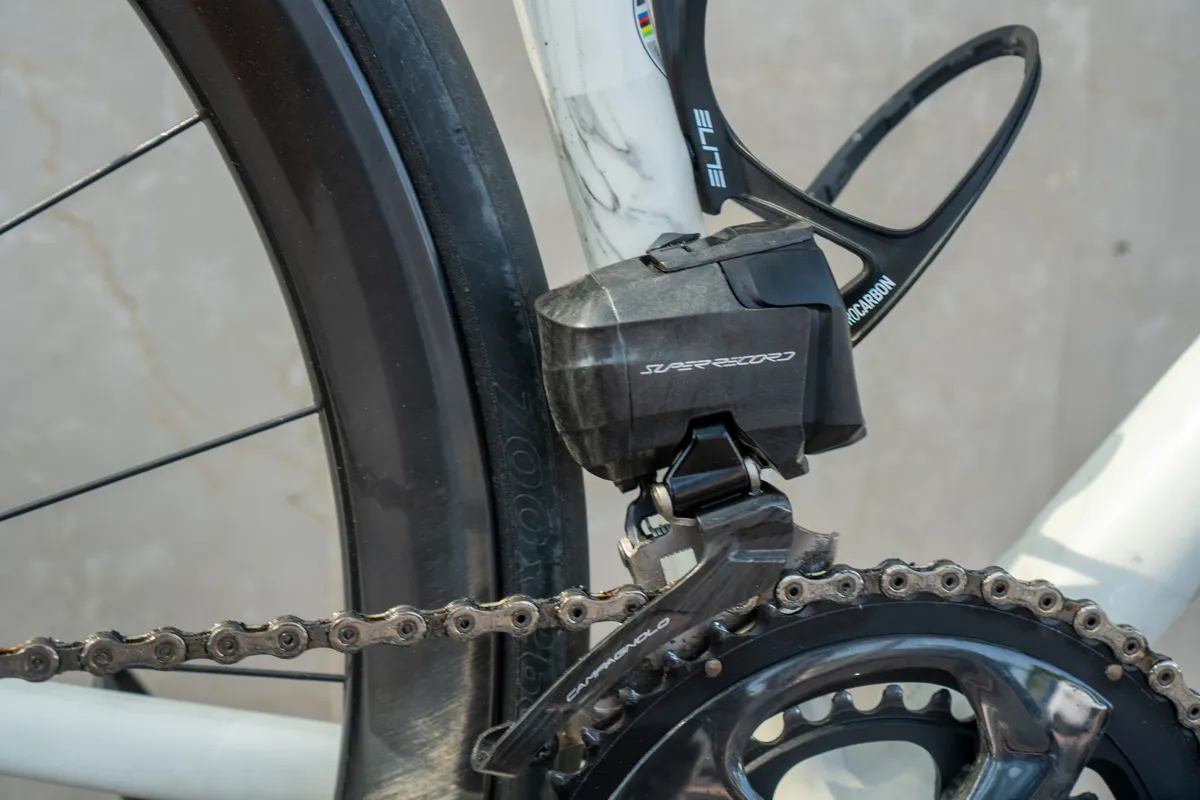
The wireless front derailleur is much wider than its predecessor and has a capacity of up to a 16-tooth difference between chainrings.
Campagnolo says you can run up to 34mm road bike tyres with the front derailleur on 410mm-length chainstays. Using larger tyres may result in the tyre fouling the front derailleur.
Like the rear derailleur, there is a button you can press to monitor battery life, and the battery is removable.
Like the outgoing Super Record EPS and Campagnolo’s mechanical groupsets, the front derailleur will include a specific alignment tool to correctly set the installation height and angle.
The front derailleur doesn’t feature any limit screws.
Campagnolo Super Record Wireless disc brake calipers
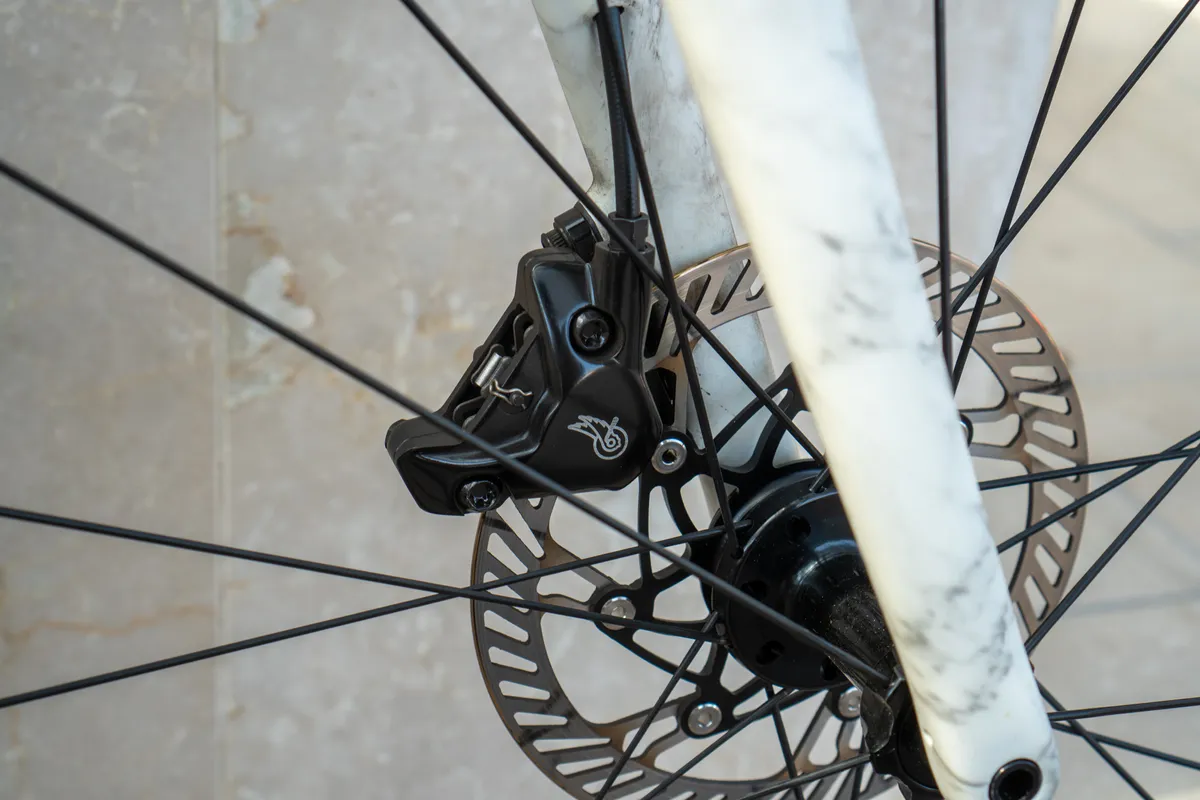
The Super Record Wireless calipers are flat-mount only and share the same internals with its other groupsets.
There are some cosmetic revisions, with Campagnolo’s signature winged wheel logo printed on the inside face of the caliper.
Campagnolo is introducing new DB-410 disc brake pads, though, which are 30 per cent lighter than the current DB-310 model, thanks to a new aluminium backing plate. Bearing in mind the DB-310s weigh a claimed 41g, this saves around 12g.
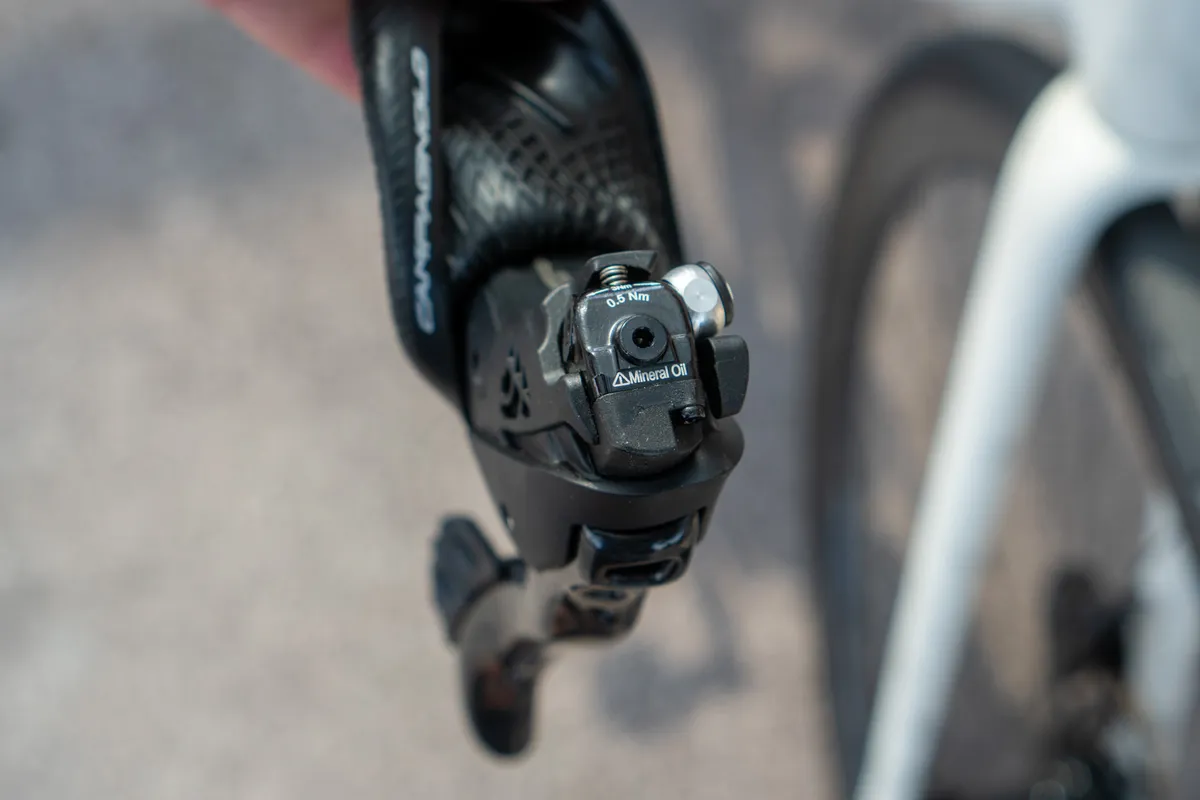
Like Ekar, the brakes use Campagnolo’s proprietary red mineral oil brake fluid. The bleeding procedure is unchanged, although the brand no longer recommends the use of Magura’s Royal Blood fluid, which was used previously on its road shifters.
The calipers are designed around the use of 140mm disc brake rotors, with 160mm discs requiring the use of an adaptor.
Campagnolo Super Record Wireless disc brake rotors
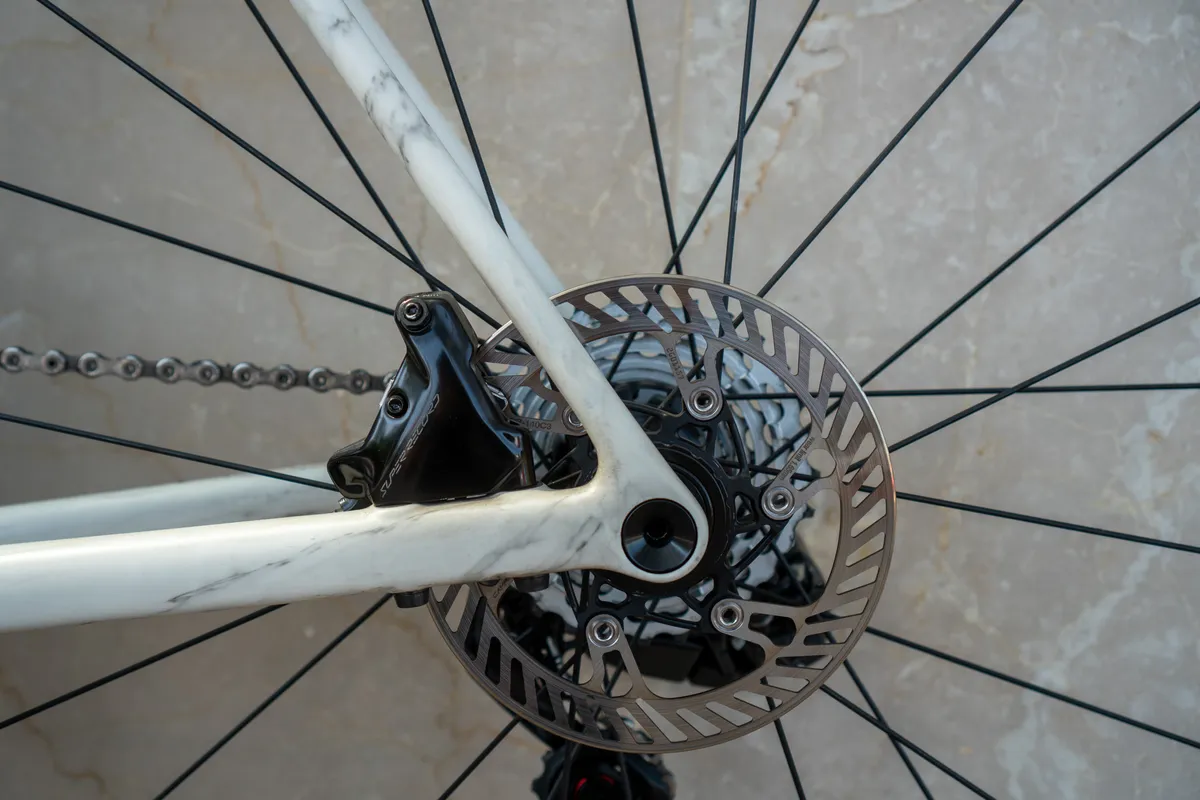
The disc brake rotors are unchanged from previous incarnations. Their patented rounded shape is said to regulate temperature and reduce risk of injury.
Campagnolo says when it was originally developing the rotors it undertook medical laboratory research and experimented with fake skin to find the best shape.
The discs are available in 140mm and 160mm sizes in Center Lock only and continue to be 1.85mm thick – a little wider than Shimano and SRAM.
Campagnolo continues to use a floating design with seven rotor carriers on the 160mm rotor and six on the 140mm.

The brand says a small amount of play is built into the rotors. This can be felt when rocking the bike back and forth with the brakes locked. Campagnolo says this enables the brake to better absorb heat when descending.
Campagnolo Super Record Wireless crankset
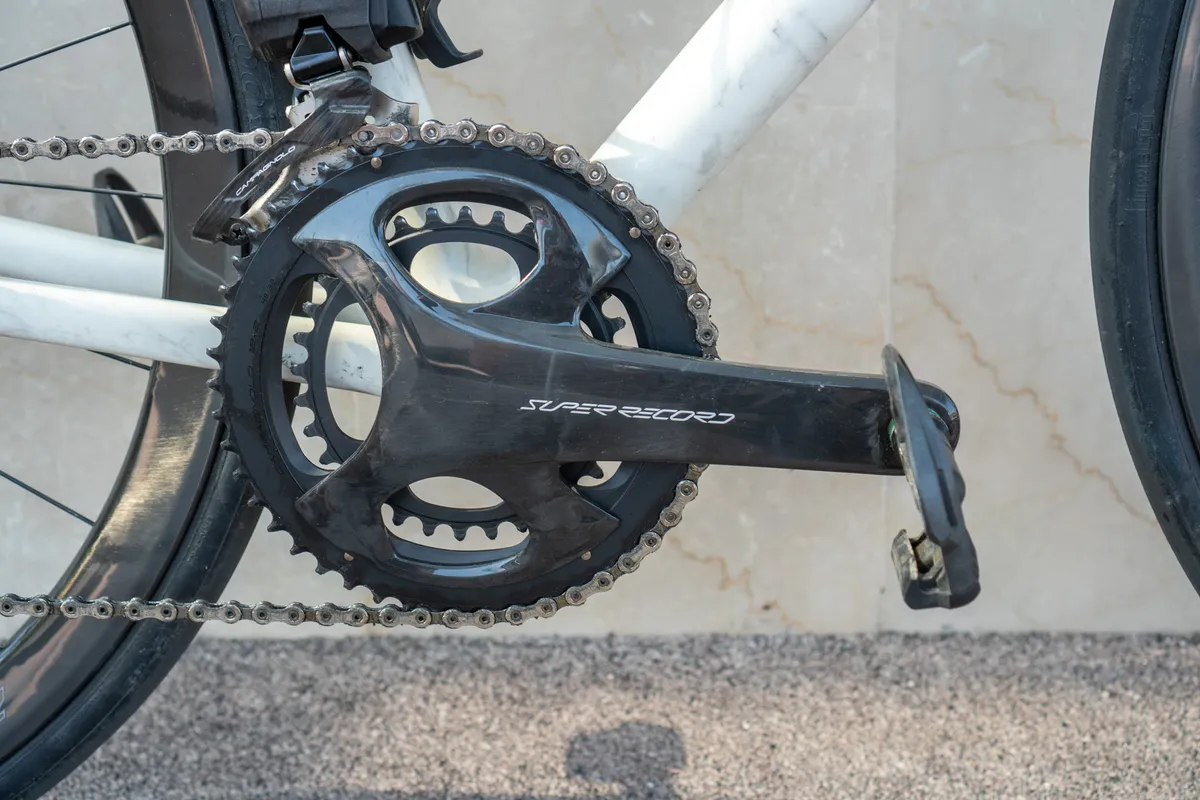
The Super Record Wireless crankset uses a four-arm design. The arms are constructed from carbon fibre and paired with a titanium axle.
The crank arms are a little smaller in profile than the outgoing Super Record to meet modern frame standards. It retains the carbon bracing for stiffness purposes.
To complement the smaller 10t starting cassette sprocket, Campagnolo is using smaller chainring sizes.
The three options are 50/34, 48/32 and 45/29-tooth, with all of the cranksets sharing an identical 121/88mm asymmetric BCD and a 45.8mm chainline.
The cranks are available in 165, 170, 172.5 and 175mm lengths. The Q-factor is 147.5mm, up from 145.5mm on previous 12-speed cranksets.
The brand says it may introduce larger chainring sizes for the pros.
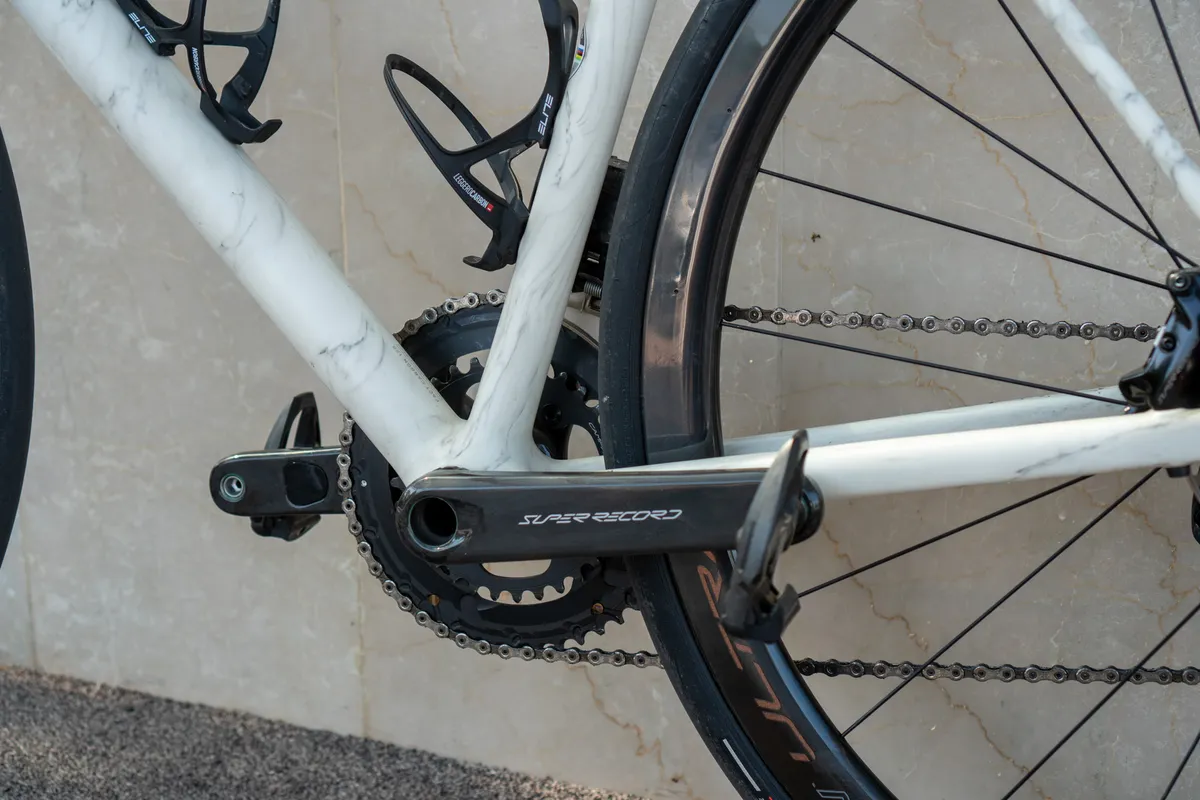
When SRAM released its eTap AXS 12-speed ecosystem, it also utilised smaller-sized chainrings – 50/37, 48/35 and 46/33. As Campagnolo intends to, SRAM produces pro-only larger chainrings.
The crankset continues to use Campagnolo’s tried-and-tested Ultra Torque system, which sees the titanium spindle split in two. The two halves are connected by a Hirth joint.
Super Record has always been the outlier of Campagnolo’s cranksets in that it uses a titanium bolt with a reverse thread to remove the cranks and that continues with this generation. Lower-tier cranksets use a steel bolt with a standard thread.
Campagnolo says you can’t run the system as a 1x drivetrain, nor did it consider collaborating with Classified for Powershift compatibility.
SRAM offers its road bike groupsets in both 1x and 2x configurations, whereas Shimano’s road groupsets all utilise 2x cranksets. Classified’s Powershift is a 2-speed gear system housed in the rear hub that effectively replaces a front derailleur.
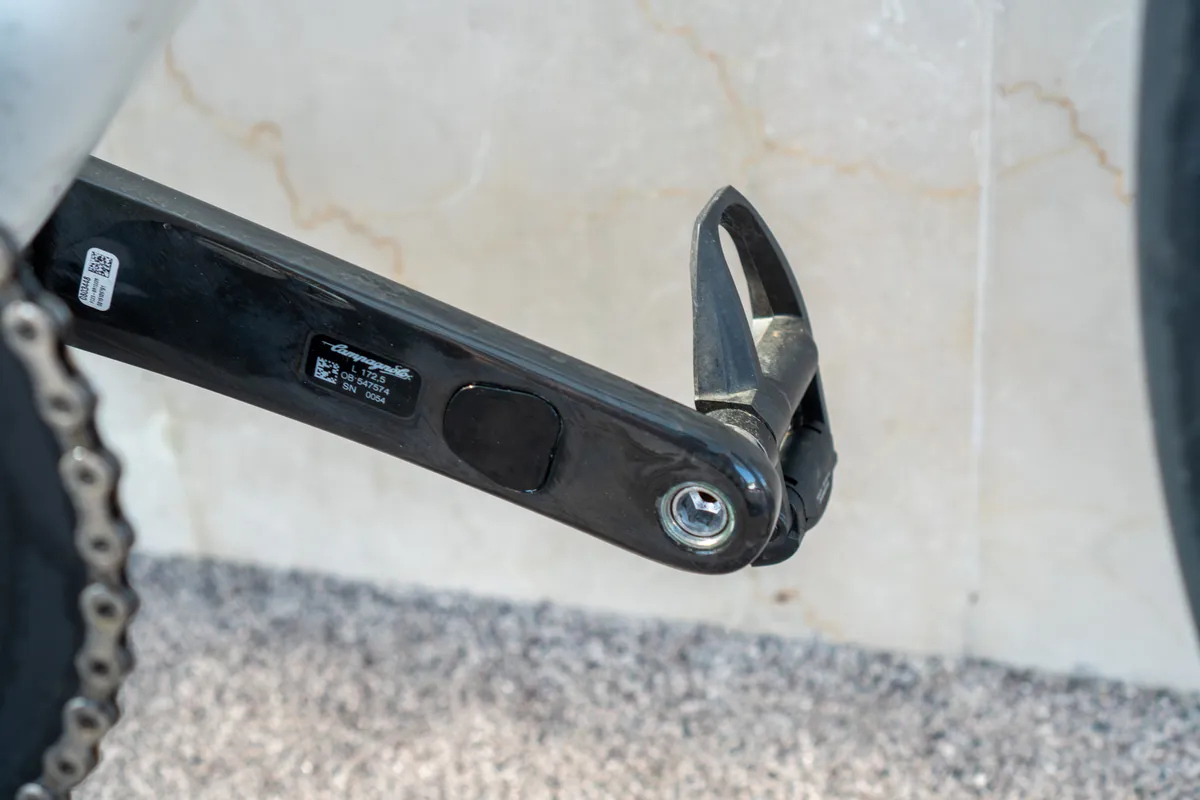
The eagle-eyed among you may spot a nodule on the inside of the crank arm. Although Campagnolo officially remains coy, this is almost certainly space for a power meter.
A patent filed by Campagnolo in 2021 suggests a power meter is in development.
Campagnolo Super Record Wireless bottom bracket
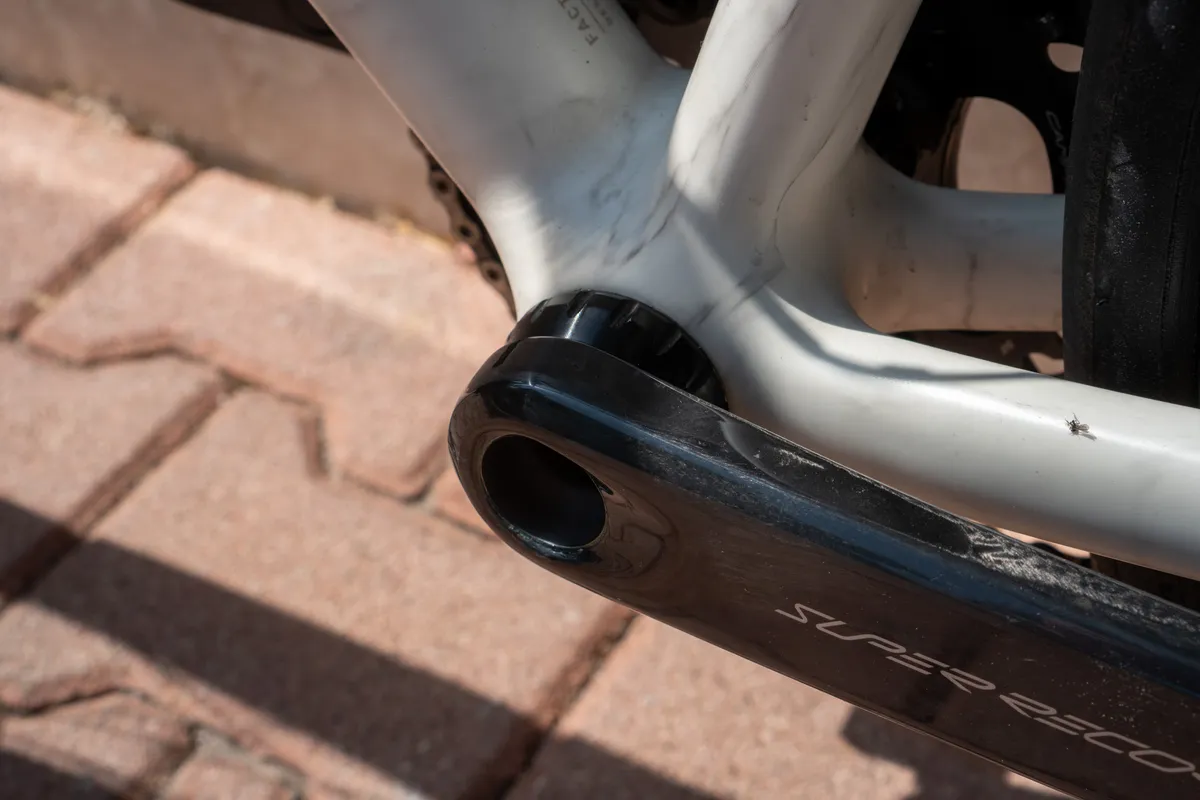
First introduced on Ekar, Campagnolo is using its ProTech bottom bracket system on Super Record Wireless.
ProTech features an additional seal and a sleeve connecting the cups to better protect the bearings against the elements. It’s already available in a number of threaded and press-fit standards.
The Super Record Wireless variant uses the brand’s USB (Ultra Smooth Bearings) ceramic bearings.
Campagnolo Super Record Wireless chain

The chain is unchanged from the previous 12-speed groupsets, barring the new option of using a joining pin or C-link (quick link).
With the exception of Ekar, all of Campagnolo’s chains have used a joining pin up to this point. The pin requires peening and only certain chain tools have this function.
The new chain is backwards-compatible with Campagnolo’s other 12-speed groupsets.
What does this mean for the future?
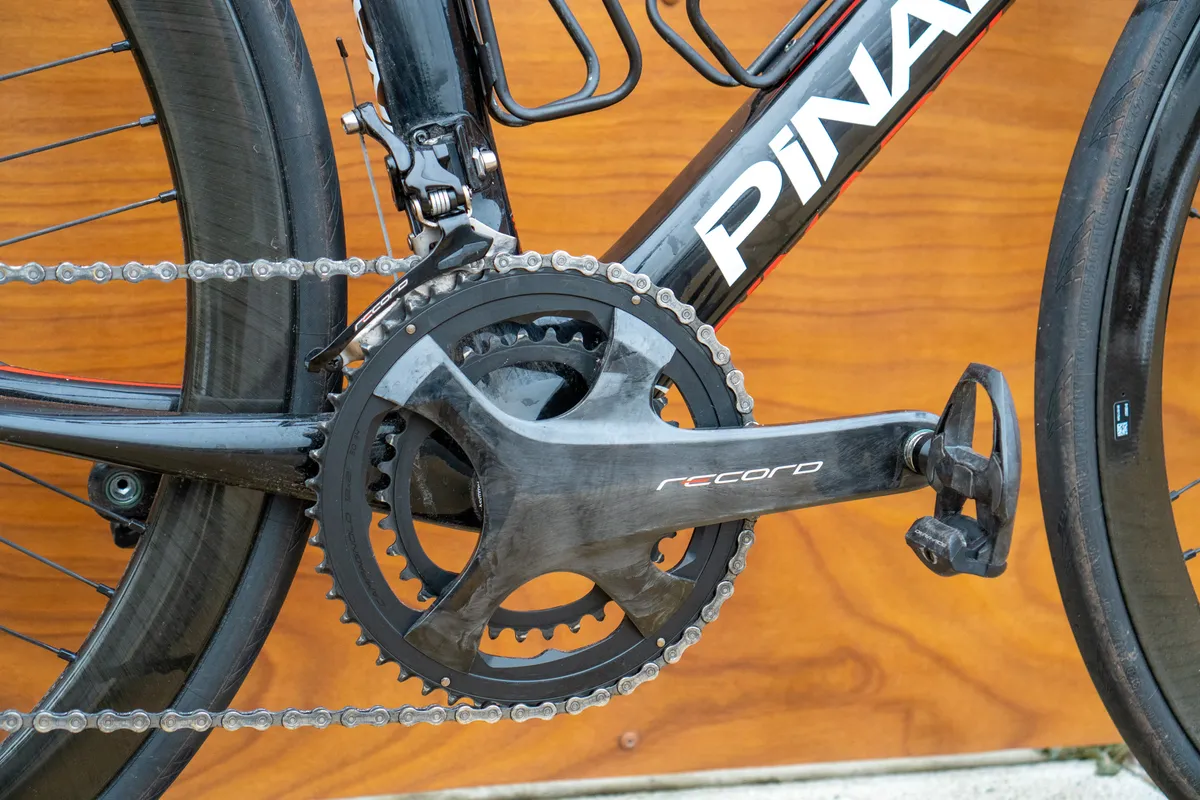
Campagnolo was tight-lipped on any specific future developments, but noted it always launches new technology at the top of the range before trickling it down.
While that means a lower-tier Wireless groupset is likely to come in the future, whether it wears the Record or Chorus name remains to be seen.
The brand says top riders in its pro teams will get to ride on Super Record Wireless first, before it trickles down to the rest of the riders. Campagnolo also confirmed there is a time-trial shifter in development.
Speaking to BikeRadar, Campagnolo confirmed that, as the market has moved on, it sees less demand for top-end mechanical groupsets. As such, the brand currently has no plans to produce an updated mechanical version of Super Record.
undefinedundefinedundefinedundefinedundefinedundefinedundefinedundefinedundefinedundefinedundefinedundefinedundefinedundefinedundefinedundefinedundefinedundefinedundefinedundefinedundefinedundefinedundefinedundefinedundefinedundefinedundefinedundefinedundefinedundefinedundefinedundefinedundefinedundefinedundefinedundefinedundefinedundefinedundefinedundefinedundefinedundefinedundefinedundefinedundefinedundefinedundefinedundefinedundefinedundefinedundefinedundefinedundefinedundefinedundefinedundefinedundefinedundefinedundefinedundefinedundefinedundefinedundefinedundefinedundefinedundefinedundefinedundefinedundefinedundefinedundefinedundefinedundefinedundefinedundefinedundefinedundefinedundefinedundefinedundefinedundefinedundefinedundefinedundefinedundefinedundefinedundefinedundefinedundefinedundefinedundefinedundefinedundefinedundefinedundefinedundefinedundefinedundefinedundefinedundefinedundefinedundefinedundefinedundefinedundefinedundefinedundefinedundefinedundefinedundefinedundefinedundefinedundefinedundefinedundefinedundefinedundefinedundefinedundefinedundefinedundefinedundefinedundefinedundefinedundefinedundefinedundefinedundefinedundefinedundefinedundefinedundefinedundefinedundefinedundefinedundefinedundefinedundefinedundefinedundefinedundefinedundefinedundefinedundefinedundefinedundefinedundefinedundefinedundefinedundefinedundefinedundefinedundefinedundefinedundefinedundefinedundefinedundefinedundefinedundefinedundefinedundefinedundefinedundefinedundefinedundefinedundefinedundefinedundefinedundefinedundefinedundefinedundefinedundefinedundefinedundefinedundefinedundefinedundefinedundefinedundefinedundefinedundefinedundefinedundefinedundefinedundefinedundefinedundefinedundefinedundefinedundefinedundefinedundefinedundefinedundefinedundefinedundefinedundefinedundefinedundefinedundefinedundefinedundefinedundefined